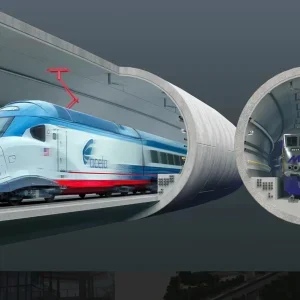On Saturday 4 June, tragedy struck again in an Alpine tunnel when a fire broke out in the 12.87km long Frejus tunnel, between France and Italy, claiming the lives of two people and leaving others being treated for smoke inhalation.
A flurry of investigations have been launched into the blaze, but initial reports suggest temperatures inside the tunnel during the fire reached 1,650°C. Six vehicles were burnt before the fire was controlled; four trucks and two fire vehicles. The fire is believed to have originated on a truck carrying tyres and quickly spread to another carrying glue.
The 9m wide Frejus tunnel had boasted sophisticated security and fire systems, with significant upgrades following 1999’s catastrophic Mont Blanc tunnel fire that killed 39 people (T&TI, February, p14). These include five emergency u-turns for coaches and goods vehicles in the event of emergencies, control station, emergency call stations and fresh air base shelters at 275m intervals directly linked to a fresh air shaft. Sadly, one of the victims, a Slovakian truck driver, was reported to have reached a refuge after fleeing from his vehicle through heavy smoke, but then collapsed. The second victim, also a Slovakian driver, was found in the same area said reports.
T&TI contacted operator of the French side, SFTRF, who said that pending legal investigations they could not comment on the fire itself, but described the initial technical investigations taking place in the aftermath to establish the damage to the tunnel, which is expected to be closed for some months.
Investigations commenced on 8 June and on 15 June SFTRF joined with Italian operator SITAF, technical experts and insurance representatives to produce an initial assessment of the fire damage. Cores and steel samples were taken to diagnose the state of the concrete and reinforcement in the affected section of tunnel. A parallel exercise was conducted to establish a base scope of expected repairs required.
As T&TI went to press specialist companies were being consulted on the installation of anchors in the crown and removing damaged concrete from the sidewalls said SFTRF. An inventory of tunnel installed equipment revealed that video surveillance, radio leaky feeders and the emergency call network had been destroyed along the 400m most affected by the blaze.
A safety committee was due to meet at the end of June to oversee the work required to reinstate the tunnel to service. At that time, the programme of works for re-opening will be more accurately known, a source from SFTRF told T&TI. French enquiries will also probe the cause of the fire and decide if criminal proceedings should be sought.
In a tragic irony the Frejus tunnel hosts CFETIT, a training centre for training in the techniques for tunnel intervention. It can only be hoped that the proximity of such a facility improved the effectiveness of the local fire crews and helped prevent an even greater loss of life.







